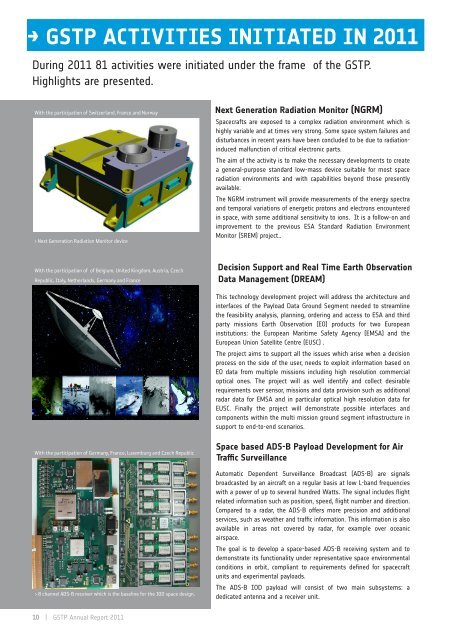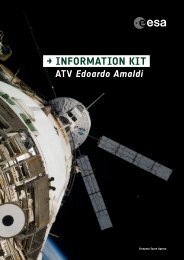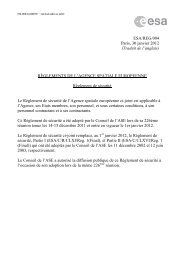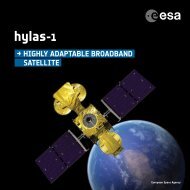→ GSTP ANNUAL REPORT 2011 - ESA
→ GSTP ANNUAL REPORT 2011 - ESA
→ GSTP ANNUAL REPORT 2011 - ESA
Create successful ePaper yourself
Turn your PDF publications into a flip-book with our unique Google optimized e-Paper software.
<strong>→</strong> <strong>GSTP</strong> ACTiviTieS iniTiATeD in <strong>2011</strong><br />
During <strong>2011</strong> 81 activities were initiated under the frame of the <strong>GSTP</strong>.<br />
Highlights are presented.<br />
With the participation of Switzerland, France and Norway<br />
> Next Generation Radiation Monitor device<br />
With the participation of of Belgium, United Kingdom, Austria, Czech<br />
Republic, Italy, Netherlands, Germany and France<br />
With the participation of Germany, France, Luxemburg and Czech Republic<br />
> 8 channel ADS-B receiver which is the baseline for the IOD space design.<br />
10 | <strong>GSTP</strong> Annual Report <strong>2011</strong><br />
next Generation radiation monitor (nGrm)<br />
Spacecrafts are exposed to a complex radiation environment which is<br />
highly variable and at times very strong. Some space system failures and<br />
disturbances in recent years have been concluded to be due to radiationinduced<br />
malfunction of critical electronic parts.<br />
The aim of the activity is to make the necessary developments to create<br />
a general-purpose standard low-mass device suitable for most space<br />
radiation environments and with capabilities beyond those presently<br />
available.<br />
The NGRM instrument will provide measurements of the energy spectra<br />
and temporal variations of energetic protons and electrons encountered<br />
in space, with some additional sensitivity to ions. It is a follow-on and<br />
improvement to the previous <strong>ESA</strong> Standard Radiation Environment<br />
Monitor (SREM) project..<br />
Decision Support and real Time earth observation<br />
Data management (DreAm)<br />
This technology development project will address the architecture and<br />
interfaces of the Payload Data Ground Segment needed to streamline<br />
the feasibility analysis, planning, ordering and access to <strong>ESA</strong> and third<br />
party missions Earth Observation (EO) products for two European<br />
institutions: the European Maritime Safety Agency (EMSA) and the<br />
European Union Satellite Centre (EUSC) .<br />
The project aims to support all the issues which arise when a decision<br />
process on the side of the user, needs to exploit information based on<br />
EO data from multiple missions including high resolution commercial<br />
optical ones. The project will as well identify and collect desirable<br />
requirements over sensor, missions and data provision such as additional<br />
radar data for EMSA and in particular optical high resolution data for<br />
EUSC. Finally the project will demonstrate possible interfaces and<br />
components within the multi mission ground segment infrastructure in<br />
support to end-to-end scenarios.<br />
Space based ADS-B Payload Development for Air<br />
Traffic Surveillance<br />
Automatic Dependent Surveillance Broadcast (ADS-B) are signals<br />
broadcasted by an aircraft on a regular basis at low L-band frequencies<br />
with a power of up to several hundred Watts. The signal includes flight<br />
related information such as position, speed, flight number and direction.<br />
Compared to a radar, the ADS-B offers more precision and additional<br />
services, such as weather and traffic information. This information is also<br />
available in areas not covered by radar, for example over oceanic<br />
airspace.<br />
The goal is to develop a space-based ADS-B receiving system and to<br />
demonstrate its functionality under representative space environmental<br />
conditions in orbit, compliant to requirements defined for spacecraft<br />
units and experimental payloads.<br />
The ADS-B IOD payload will consist of two main subsystems: a<br />
dedicated antenna and a receiver unit.

















